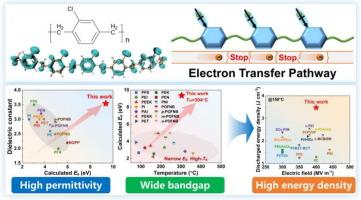Excellent high-temperature energy storage performance of polymer dielectrics through the synergistic action of conjugation effect inhibition and dipole modulation
IF 13.3
1区 工程技术
Q1 ENGINEERING, CHEMICAL
引用次数: 0
Abstract
High-temperature polymer dielectrics with efficient energy storage are essential for modern power electronics, but their narrow bandgap and restricted dielectric constant contribute to low energy density and efficiency at high temperatures. In order to address this issue, a high-temperature polymer (Parylene C) with both a wide bandgap and a high dielectric constant has been developed using conjugate effect confinement and dipole modulation strategies. Non-conjugated vinyl groups were introduced into the aromatic backbone to discourage conjugation while maintaining thermal stability. Simultaneously, highly polar chlorine atoms were added to the aromatic ring to enhance dipole moments and increase the dielectric constant. The resulting polymers exhibit high discharged energy density (Ue) and high discharging efficiency at both room and elevated temperatures. Notably, under classical operating conditions (150 °C, 200 MV m−1), Parylene C exhibits a Ue of 1.2 J cm−3, which is more than twice that of most commercially available high-temperature polymers (∼0.5 J cm−3), while also demonstrating excellent cycling stability. By balancing the contradiction between band gap and dielectric constant through a molecular design strategy, this study achieves high energy storage at elevated temperatures and offers a novel approach for developing high-energy density, low-dielectric loss and high-temperature resistance polymers.

通过共轭效应抑制和偶极调制的协同作用,聚合物电介质具有优异的高温储能性能
具有高效储能功能的高温聚合物电介质是现代电力电子技术的重要组成部分,但其窄带隙和介电常数限制导致其在高温下能量密度和效率较低。为了解决这一问题,利用共轭效应约束和偶极子调制策略,开发了一种既具有宽禁带又具有高介电常数的高温聚合物(聚对二甲苯C)。在芳香骨架中引入非共轭乙烯基以抑制共轭,同时保持热稳定性。同时,在芳环中加入高极性氯原子,增强偶极矩,提高介电常数。所得到的聚合物在室温和高温下均表现出高放电能量密度(Ue)和高放电效率。值得注意的是,在经典操作条件下(150 °C, 200 MV m−1),聚对二甲苯C的Ue值为1.2 J cm−3,是大多数商用高温聚合物(~ 0.5 J cm−3)的两倍多,同时也表现出出色的循环稳定性。本研究通过分子设计策略平衡带隙和介电常数之间的矛盾,实现了高温下的高能量存储,为开发高能量密度、低介电损耗和耐高温聚合物提供了新的途径。
本文章由计算机程序翻译,如有差异,请以英文原文为准。
求助全文
约1分钟内获得全文
求助全文
来源期刊

Chemical Engineering Journal
工程技术-工程:化工
CiteScore
21.70
自引率
9.30%
发文量
6781
审稿时长
2.4 months
期刊介绍:
The Chemical Engineering Journal is an international research journal that invites contributions of original and novel fundamental research. It aims to provide an international platform for presenting original fundamental research, interpretative reviews, and discussions on new developments in chemical engineering. The journal welcomes papers that describe novel theory and its practical application, as well as those that demonstrate the transfer of techniques from other disciplines. It also welcomes reports on carefully conducted experimental work that is soundly interpreted. The main focus of the journal is on original and rigorous research results that have broad significance. The Catalysis section within the Chemical Engineering Journal focuses specifically on Experimental and Theoretical studies in the fields of heterogeneous catalysis, molecular catalysis, and biocatalysis. These studies have industrial impact on various sectors such as chemicals, energy, materials, foods, healthcare, and environmental protection.
 求助内容:
求助内容: 应助结果提醒方式:
应助结果提醒方式:


